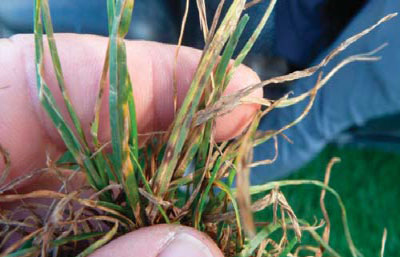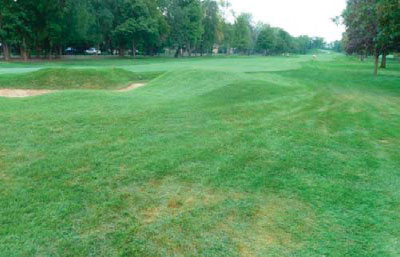Helminthosporium Disease Solutions
Helminthosporium are diseases of turf caused by fungal pathogens in the genera Dreschlera, Bipolaris and Exserohilum. Sometimes these diseases are referred to as leaf spot or melting out.
Overview
The problem
Helminthosporium are diseases of turf caused by fungal pathogens in the genera Dreschlera, Bipolaris and Exserohilum. Sometimes these diseases are referred to as leaf spot or melting out.
These pathogens can be active on turfgrass throughout the year under wet conditions and during periods of plant stress. Disease pressure is typically highest when daytime temperatures are between 16 and 18°C during the spring and autumn, but may also occur at high temperatures under periods of heat or drought stress, followed by rain or heavy irrigation. Poor irrigation or fertility practices (e.g. too much or too little), shade and soil compaction can contribute to disease development.
What to look for
Leaf spot and melting out fungi cause leaf spot as well as crown, stolon and root rots. Symptoms on cool season turf include the development of irregular patches of reddish-brown, thinned turf. Dark lesions with tan to white centres develop on leaves and may completely blight out infected tissues. Leaf lesions may be confused with those caused by grey leaf spot. Brown to reddish-brown lesions and streaks may be associated with some Fescues and Ryegrasses. Infected crowns and stolons will often take on a dry rotted appearance.
Signs of the pathogen include the presence of dark oval or cigar-shaped conidia formed on infected tissue. Often, infected tissue will sporulate profusely and be covered with dark spores after overnight incubation in a moist chamber.
 |
 |
The Solution
Leaf spot and melting out diseases often occur under stress conditions and proper cultural practices will help avoid these diseases. Some cultural practices include: raising the mowing height, mowing regularly to prevent scalping and avoiding excessive nitrogen and thatch. Reduce leaf wetness periods by improving air movement, soil drainage and using proper irrigation practices. If plants are experiencing heat and drought, syringe the turf to prevent stress and wilt.
Protect cool season turfgrass during periods of stress with preventive fungicides. Start preventive fungicide applications in the spring and/or autumn when average maximum air temperatures are at or above the range 16–18°C in moist or wet weather. Additional applications may be needed when weather conditions are extreme; either excessively wet and overcast, or hot and dry conditions can stress cool season turf and trigger leaf spot outbreaks.
Dedicate® Forte Stressgard® is the premier solution for controlling Helminthosporium disease. Stressgard technology also helps reduce the turfgrass stresses that allow these diseases to develop. Interface also has a proven history of Helminthosporium disease control.
Technical Information
| Solution1 | Rate | Application Interval |
| Dedicate Forte® Stressgard | 3.5 L/ha | Apply on a 14-28-day spray interval when conditions are favorable for disease development. Use the shorter spray interval under high disease pressure or for curative treatment. |
| Interface® StressGard | 12.5 L/ha | 7–14 days for curative control Monthly for preventative control |
1. Always read and follow label instructions carefully.
To find out more information about our products and services, reach out to our team.
Always read the label before use.
Back to Other Diseases